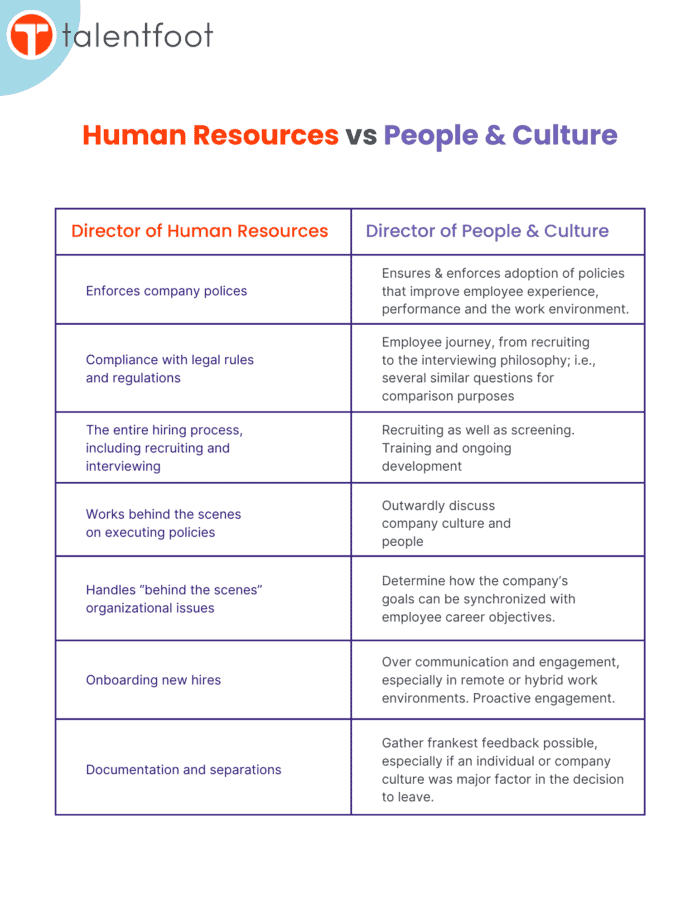Over the last several years, I’ve noticed a trend in HR hiring. CEOs are ready to hire a Director of People and Culture. Sometimes, they want to forgo any human resources full-time employees to, as they say, prioritize people and culture.
I’m glad to see organizations looking inward at the employee experience and focusing on their people. For most organizations, though, an HR executive and a people and culture leader are equally as beneficial.
“The pandemic showed HR is as relevant to business success as typical core functions like R&D, sales, or production. In fact, it was our duty as HR to ensure the entire company could still be operational during the pandemic,” a CHRO of a European semiconductor company told McKinsey.
We’ve always known these roles are crucial within an organization. The past two years have highlighted the value of a company’s people and its relationship with them. Human Resources as we once knew it has evolved.
Enter People & Culture.
Before we get into the fine print, this is your major takeaway: hiring a leader of people and culture instead of an HR leader reflects the business philosophy of a company’s leadership. At its core, it is the difference between management and leadership; between the administration of rules and regulations, and employee engagement and development.

An Example
Let’s start with a specific example, hiring.
When it comes to bringing in new employees, the human resources department spends its time on the boxes that need to be checked; I.e., recruiting, interviewing, hiring, onboarding, maintaining employee documentation, and separations.
Meanwhile, the People and Culture team focuses on the employee journey and experience; from recruiting through separation, from the interviewing philosophy (recruiting as well as screening), ongoing training and professional development, and how the company needs to intersect with the employee’s career goals.
In an organization with both a Director of HR and a Director of People and Culture, HR spends more time on operations.
When to Hire a Director of HR
Hiring a Director of Human Resources is the right way to go when the company needs an executive to own one or more functions beneath the HR umbrella; talent acquisition, benefits, compliance, employee health and safety, benefits, etc.
A Director of Human Resources constructs company policies and enforces them. This leader often works behind the scenes. They are the architect of policies and then they are responsible for executing them. Conversely, the Director of People and Culture is a more outward-facing position.
In growing early to mid-stage companies, the ideal Director of HR will be a subject matter expert in both HR and people and culture. They must be fluent with policies, compliance, legal, benefits, etc., the core competencies of HR.
However, because day-to-day HR administration is time-consuming, combining HR and people and culture responsibilities to one executive will not work at scale.
When to Hire a Director of People and Culture
When a company wants to adopt a people-centric approach, it should consider hiring a people and culture leader.
Often this leader reports to the head of human resources to concentrate solely on the people and cultural aspects of the organization. Depending on the organization’s goals, the Director of People and Culture typically owns employee relations and builds a culture that promotes growth, productivity, and innovation. They play a key in role if a company needs to transform how a it attracts, develops and retains the human beings that execute the company’s strategic vision.
This executive is very visible within an organization. They are responsible for the policies that improve the employee experience. The Director of People and Culture is the employee advocate to the leadership team. Additionally, they open a two-way dialogue with employees to get honest feedback from the people.
Positioning an Organization for Success
Take a snapshot of where your organization is today and where you want to be. Are you growing rapidly? Do you have an in-house HR function in place? Remember, the key difference between these rules lies between the administration of rules and regulations, and employee engagement and development.
As companies continue to scale, the importance of culture becomes more apparent, especially as it impacts attrition and the staggering costs associated with it. The cliché’ is true – people quit their managers more than they quit their company. A Director of People and Culture and a Director of Human Resources are critical to positions when it comes to your most critical resource – your people.
Are you uncertain what the right hire is for your business needs, objectives, and budget? After reading this, you might still wonder what your organization needs. Contact us and we can help you strategize your next hire.




